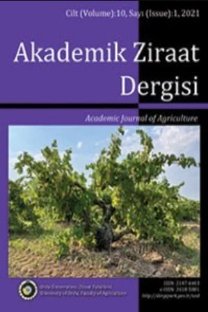Akdeniz Bölgesi’nde yetiştirilen bazı Nar (Punica granatum L.) çeşit ve genotiplerinin organik asit ve şeker kompozisyonu
Pomegranate organic acid, sugar,
___
Al-Maiman, S.A. and Ahmad, D., 2002. Changes in physical and chemical properties during pomegarnate [Punica granatum] fruit maturation. Food Chemistry, 76: 437- 441.Aviram, M. and Dornfeld, L., 2001. Pomegranate juice consumption inhibits serum angiotensin converting enzyme activity and reduces systolic blood pressure. Atherosclerosis, 158: 195–198.
Aviram, M., Dornfeld, L., Rosenblat, M., Volkova, N., Kaplan, M., Coleman, R., Hayek, T., Presser, D., Fuhrman, B., 2000. Pomegranate juice consumption reduces oxidative stress, atherogenic modifications to LDL, and platelet aggregation: studies in humans and in atherosclerotic apolipoprotein E-deficient mice. The American Journal of Clinical Nutrition, 71: 1062-1076.
Aviram, M., Rosenblat, M., Gaitini., D., Nitecki, S., Hoffman, A., Dornfeld, L., Volkova, N., Presser, D., Attias, J., Liker, H., Hayek, T,. 2004. Pomegranate juice consumption for 3 years by patients with carotid artery stenosis reduces common carotid intimamedia thickness, blood pressure and LDL oxidation. Clinical Nutrition, 23: 423–433.
Bartolozzi, F., Bertazza, G., Bassi, D., Cristoferi, G., 1997. Simultaneous GLC determination of soluble sugars and organic acids as trimethylsilyl derivates in apricot fruits by gas liquid chromatography. J. Chromatography 758:199-107.
Cemeroğlu, B., 2007. Gıda Analizleri. Gıda Teknolojisi Derneği Yayınları, No: 34, Bizim Büro Basımevi, Kızılay, Ankara, 535 s.
Cemeroğlu, B., Artık, N., Yüncüler, O., 1988. Nar suyu üzerinde araştırmalar. Doğa, 12 (3): 322-334.
Çam, M., Hisil, Y., Durmaz, G., 2009. Characterizations of pomegranate juices from ten cultivars grown in Turkey. International Journal of Food Properties, 12(2): 388 -395.
Düzgüneş, O., Kesici, T., Kavuncu, O., Gürbüz, F., 1987. Araştırma ve Deneme Metodları, Ankara Ünv. Zir. Fak. Yayınları, No: 1021, Ankara, 229 s.
Ekşi, A. and Özhamamcı, İ., 2009. Chemical Composition and Guide Values of Pomegranate Juice. Gıda, 34 (5): 265-270.
Fadavi, A., Barzegar, M., Azizi, M. H.,Bayat, M., 2005. Note. Physicochemical Composition of Ten Pomegranate Cultivars (Punica granatum L.) Grown in Iran. Food Science and Technology International, 11: 113-119. Gil, M.I., Tomas-Barberan, F.A., Pıerce, B.H., Holcroft.,D.M., Kader, A.A., 2000. Antioxidant activity of pomegranate juice and its relationship with phenolic composition and processing. Journal of Agricultural Food Chemistry, 48: 4581-4589.
Gölükcü, M. ve Tokgöz, H., 2008. Ülkemizde Yetiştirilen Önemli Nar (Punica granatum) Çeşitlerine ait nar sularının bazı kalite özellikleri. Hasad Gıda, 274: 26Kulkarni, A.P. and Aradhya, S.M., 2005. Chemical changes and antioxidant activity in pomegranate arils during fruit development. Food Chemistry, 93:3193
Kurt, H. ve Şahin, G., 2013. Bir ziraat coğrafyası çalışması: Türkiye’de nar (Punica granatum L.) tarımı. Marmara Coğrafya Dergisi, 27: 551-574.
Martinez, J. J., Melgarejo, P., Hernandez, F., Salazar, D. M., Martinez, R., 2006. Seed characterisation of five new pomegranate (Punica granatum L.) varieties. Scientia Horticulturae, 110: 241–246. 42 ___________________________________________________________________________________________________________ Turgut, D.Y., Seydim, A.C.
Melgarejo, P., Salazar, D.M., Artes, F., 2000. Organic acids and sugars composition of harvested pomegranate fruits. European Food Research and Technology, 211: 185–190.
Özgen, M., Durgaç, C., Serçe, S., Kaya, C., 2008. Chemical and antioxidant properties of pomegranate cultivars grown in Mediterranean region of Turkey. Food Chemistry, 111: 703–706.
Özhamamcı, İ., 2008. Nar Suyunun Kimyasal Bileşimi ve Tanı Değerleri. Ankara Üniversitesi Fen Bilimleri Enstitüsü, Yüksek Lisans Tezi, Ankara, 42 s.
Poyrazoğlu, E., Gökmen,V., Artık, N., 2002. Organic acid and phenolic compounds in pomegranates [Punica granatum L.] grown in Turkey. Journal of Food Composition and Analysis, 15 (5): 567-575.
Savran, H.E., 1999. Nar suyunda organik asit dağılımı. Ankara Üniversitesi Fen Bilimleri Enstitüsü, Yüksek Lisans Tezi, Ankara, 46 s.
- ISSN: 2147-6403
- Yayın Aralığı: Yılda 2 Sayı
- Başlangıç: 2012
- Yayıncı: Ordu Üniversitesi Ziraat Fakültesi
Türkiye'de kooperatiflere ortak olmada ve kooperatif başarısında etkili faktörlerin analizi
Ahmet ŞAHİN, Cihat GÜNDEN, Murat CANKURT, Yeşim MERAL, Bülent MİRAN
Verilerin grup veya bireysel olarak alınmasının araştırma sonuçlarına etkisi
İsmail DURMUŞ, Fatih ÜÇKARDEŞ, Şahnur Erdoğan DEMİRTAŞ, Meltem GÜLTEKİN, Sunay DEMİR
Atıf Can SEYDİM, Demet TURGUT YILDIZ
Atlarda yürüyüş çeşitleri ve kusurları
Orhan YILMAZ, Saim BOZTEPE, Mehmet ERTUĞRUL
Gait types and faults in horses
Piraziz elmasında klon seleksiyonu
Turan KARADENİZ, E.tarık AKDEMİR, İlker YILMAZ, Habib AYDIN
Demet YILDIZ TURGUT, Atıf Can SEYDİM
Türkiye’de kooperatiflere ortak olmada ve kooperatif başarısında etkili faktörlerin analizi
Ahmet ŞAHİN, Murat CANKURT, Cihat GÜNDEN, Bülent MİRAN, Yeşim MERAL
A fast approach to select the appropriate test statistics
Fatih ÜÇKARDEŞ, Elif ASLAN, Hande KÜÇÜKÖNDER
